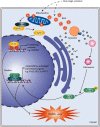Reactive Oxygen Species as a Link between Antioxidant Pathways and Autophagy
- PMID: 34336103
- PMCID: PMC8324391
- DOI: 10.1155/2021/5583215
Reactive Oxygen Species as a Link between Antioxidant Pathways and Autophagy
Abstract
Reactive oxygen species (ROS) are highly reactive molecules that can oxidize proteins, lipids, and DNA. Under physiological conditions, ROS are mainly generated in the mitochondria during aerobic metabolism. Under pathological conditions, excessive ROS disrupt cellular homeostasis. High levels of ROS result in severe oxidative damage to the cellular machinery. However, a low/mild level of ROS could serve as a signal to trigger cell survival mechanisms. To prevent and cope with oxidative damage to biomolecules, cells have developed various antioxidant and detoxifying mechanisms. Meanwhile, ROS can initiate autophagy, a process of self-clearance, which helps to reduce oxidative damage by engulfing and degrading oxidized substance. This review summarizes the interactions among ROS, autophagy, and antioxidant pathways. The effects of natural phytochemicals on autophagy induction, antioxidation, and dual-function are also discussed.
Copyright © 2021 Dan Li et al.
Conflict of interest statement
The authors declare that they have no conflicts of interest.
Figures



References
Publication types
MeSH terms
Substances
LinkOut - more resources
Full Text Sources
Medical

